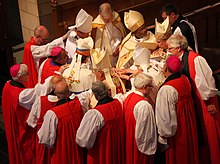Chimere
A descendant of a riding cloak, the chimere resembles an academic gown but without sleeves, and is usually made of scarlet or black cloth.
Due to liturgical changes in the later nineteenth and twentieth centuries, it is no longer common for the chimere to be worn when celebrating the Eucharist, though the practice is still kept by some low-church bishops.
When this practice ceased, the distinction was largely ignored, as in recent times many bishops regularly wear the red chimere, regardless of academic status.
The origin of the chimere has been the subject of much debate; the view of it as a modification of the cope has been discarded, and it is practically proved to be derived from the mediaeval tabard (tabardum, taberda or collobium), an upper garment worn in civil life by all classes of people both in England and abroad.
However, the word properly applies to the sleeveless tabard which tended to supersede, from the 15th century onwards, the inconvenient cappa clausa (a long, closed cloak with a slit in front for the arms) as the out-of-doors upper garment of bishops.
Thus, in the inventory of Walter Skirlawe, Bishop of Durham (1405–1406), eight chimeres of various colors are mentioned, including two for riding (pro equitatura).
This direction was added to the Book of Common Prayer in 1662, and there is proof the development of the chimere into at least a choir vestment was subsequent to the Reformation.
John Foxe, indeed, mentions that Hooper at his consecration wore a long scarlet "chymere" down to the foot (Acts and Mon., ed.
The same ecclesiologists identified the zimarra with the epitogium, which was described as “the uppermost garment of the clergy, worn over the soutane, instead of the mantellum.” In France and Germany, it was fitted more or less to the figure; in Italy it was wider and fell down straight in front.
In Italian, the term zimarra is generally used not of a close-fitting garment, such as the cassock, but of a loose over-garment, similar to the fur-lined Schaube used in northern Europe.
If an Anglican bishop is part of the "platform party" at a commencement (that is, the speaker, or is giving the invocation or benediction) he may wear the rochet and chimere with the appropriate hood and academic cap.

